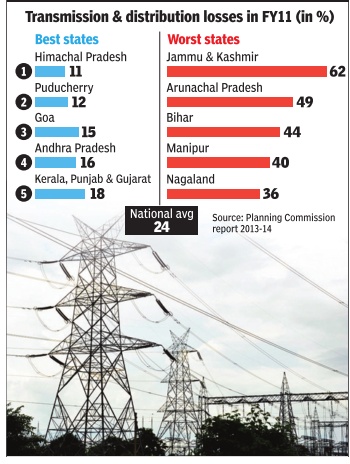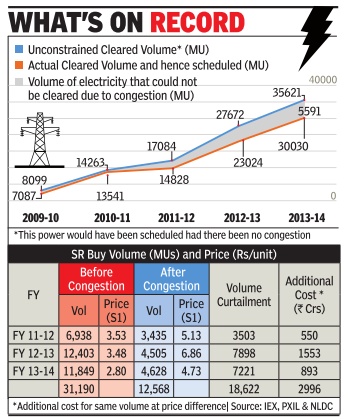Power: India, 1

What Is the Difference Between Power and Energy? The Staff of QUEST explains:
The word “energy” is used to describe many different things—how we heat and cool our homes, how we fuel cars. Energy isn’t something that can be seen or felt, but you can see and feel the effects when energy is transferred from one place to another.
Energy is what makes change happen and can be transferred form one object to another. Energy can also be transformed from one form to another.
Power is the rate at which energy is transferred. It is not energy but is often confused with energy. The watt is the most commonly used unit of measure for power. It measures the rate of energy transfer.
A watt equals a joule per second. If a smart phone uses five joules of energy every second, then the power of the phone is five joules per second, or five watts.
Indpaedia has separate pages on
Energy: India and
Power: India, 1
Power: India, 2 (ministry data
This article has been sourced from an authoritative, official readers who wish to update or add further details can do so on a ‘Part II’ of this article. |
Contents |
Transmission lines and the law
SC: No need for landowner's nod to lay power line
Dhananjay Mahapatra, Dec 30, 2016: The Times of India
Removing roadblocks in reaching electricity to every village, the Supreme Court has ruled that no prior consent of landowners was required to lay overhead power transmission lines and erect towers to support these lines.
Through the judgment, the SC settled the issue which gave rise to conflicting judgments from various HCs. The SC's top priority was to enable the go vernment and its agencies to get electricity to the last household in the remotest areas.
A bench of Justices A K Sikri and R Banumathi said, “It is well known that India is an energy deficient country.There are many households where lighting even an electric bulb is a dream.“
The issue was filed by a cement manufacturer from Chhattisgarh and Power Grid Corporation. The cement manufacturer challenged Power Grid's decision to erect towers for transmission lines on its limestone mine lease area without its consent. The bench said, “As per the provisions of the Indian Telegraph Act, unobstructed access to lay down telegraph andor electricity transmission lines is an imperative in the larger public interest.“
Indian coal-based plants and pollution
Feb 23 2015
CSE's study rates 47 coal-based plants
A first-ever environmental rating of coalbased power plants has found that India's thermal power generating units figure among the world's “most inefficient“ in terms of compliance to pollution norms, use of resources and overall operation efficiency . Though private sector thermal plants in the country perform better than governmentowned ones, there is “immense scope for improvement“ in almost all units so that they can pollute less and generate more electricity with efficient use of available resources.
The study behind the ratings, done by experts at the Centre for Science and Environment (CSE), also noted that Delhi is home to one of the most polluting power plants in the country NTPC's Badarpur Thermal Power Plant which has contributed in turn ing the capital into the most polluted city in the world.
The study , done under CSE's Green Rating Project (GRP), analysed and rated 47 coal-based thermal power plants from across the country on a variety of environmental and energy parameters. About half of all plants operating in 2011-12 were selected for the rating.
“The objective of the study was to give a clear picture of the environmental performance of the sector. Our finding is that in India, where demand for power is increasing, power plants are performing way below the global benchmarks“, said Sunita Narain ahead of the study's release on Saturday.
She said, “Given the rapid increase in coal-based power projected by the government, stress on precious resources like water and land will increase and air and water pollution will worsen unless corrective measures are taken by the industry and policy-makers“.
The study was released jointly by M S Swaminathan, environment secretary Ashok Lavasa and chief economic advisor Arvind Subramanian in a function here, organized to award the greenest power plants.
Three top power plants (CSESBudge Budge, JSWELToranagallu and Tata-Trombay) were awarded for their overall environmental performance, while two others received awards for their efficient use of resources such as energy and water.
The study found that the country's thermal power plants are estimated to draw around 22 billion cubic meter of water, which is over half of India's domestic water need.It also noted that 55% of the units were violating air pollution standards which are already extremely lax.
Electricity consumption (2015 study)
The Times of India Jan 11 2016
Chittaranjan Tembhekar
Mumbai
The Indian winter appears to be the warmest in Mumbai if we go by the pattern of electricity consumption of air conditioners and refrigerators across India's four major metros. It's high time Mumbaikars' fight against global warming is intensified as even during colder days their refrigerators and ACs are guzzling power much more than those living in other metros such as Kolkata and Bengaluru, whose temperature patterns are more or less similar to the maximum city .
A study by The Energy and Resources Institute (TERI) conducted in 2015 on behalf of the Bureau of Energy Efficiency, finds Mumbai's consumption of power for refrigerators and air-conditioners (as percentage of power consumed by a household) is the highest among the households surveyed in Mumbai, Delhi, Kolkata and Bengaluru in both autumn and winter seasons respectively . Over 800 households were surveyed in each of these cities as part of the study .
Experts agree Mumbai obviously will spend more than Delhi, where winters are cold and autumns pleasant, but criticise Mumbaikars for spending so much more on air-conditioners than Calcutta and Bangalore.
While in autumn Mumbai showed 26.4% power consumption by a refrigerator in an average household, in winter it showed 45%, much high er among the four metros. For air conditioners a city household showed an average of 19.3 % power consumption in autumn while in winter it stood at 7.9% which is again much higher than remaining three cities surveyed during the study .
Power expert Ashok Pendse said air-conditioners were the killer for Mumbai as against 3200 MW consumption during summer, winter consumption of the city stood at just 1500 MW. “Keeping AC temperature between 24 and 26, servicing it regularly , avoiding its excess use, going for LED and star-rated gadgets, and strengthening greenery and avoiding vehicle pollution were the steps needed to be taken by Mumbaikars to counter the global warming which is indicative with the growing use of ACs,“ he said.
It may be recalled that a similar study made by BEE through TERI in 2009 had suggested that Mumbaikars' consumption on refrigerators, air conditioners and geysers was more than those living in Delhi, Bengaluru and Kolkata.
The survey had revealed that Mumbai's consumption was all time high across all four seasons summer, winter, spring and autumn. Among these three gadgets, as per 2009 study , Mumbai had consumed the most on refrigerators and air conditioners whereas Delhi consumed highest power on geyser during prolonged winter months followed by Kolkata.
2016: E-bidding helps cut power tariff
The Times of India, May 24 2016
The power ministry's move to channel procurement of short-term power by states through reverse auction on its e-bidding platform appears to be paying off. The first round of bidding on the DEEP (Discovery of Efficient Electricity Price) portal has seen tariffs go down by more than a third from a year-ago period.
Uttarakhand, Kerala, Bihar and private discom Torrent Power kicked off the DEEP bidding process, with Kerala discovering a price of Rs 3.14 per unit, the lowest for May in the slot of the day , against Rs 4.70 per unit paid for roundthe-clock supplies in 2015.
Uttarakhand discovered a price of Rs 2.59 per unit, the lowest for July on round-theclock basis. The state discoms had procured short-term power at Rs 3.41 per unit last year in the same period. Bihar received the lowest rate for July at Rs 3.08 per unit, while Torrent Power received the lowest price of Rs 2.95 per unit for May-June in slot of the day . While the state did not procure power through bidding before this, Torrent did not procure short-term power in 2014-15 and 2015-16. Bidding for Uttarakhand and Kerala concluded on April 29, for Torrent Power Ltd on May 3 and for Bihar on May 9, the power ministry said on Sunday .
Lower prices are expected to reduce the overall cost of procurement of power for dis coms and ultimately benefit consumers. Power minister Piyush Goyal had inaugurated the portal, making it mandatory for discoms to procure short-term power through reverse e-bidding.
Inter-region transfer
The Times of India, Jul 05 2015

Sanjay Dutta
Supply from surplus to deficit regions blocked
It is the height of paradox for a country where blackouts are more a norm than exception. Over 3 billion units of electricity , or a day's national consumption, were wasted in 2014-15 as congestion in the transmission highways blocked trading between surplus and deficit regions. Data from various power exchanges show a higher wastage in 2013-14 at 5.3 billion units, or Delhi's consumption for roughly 56-60 days.
Inter-region transfer through short-term open access stood at 78.38 billion units during this period. No doubt, such wastage both in terms of actual power fed into the grid but not used and generation capacity that was not `scheduled' due to grid bottlenecks comes at a cost to the economy in terms of lost opportunities and idling power stations.
But even consumers, especially in deficit southern region, end up paying more as transmission gridlock not only affects volumes traded but also the price of electricity .
Power is traded on bourses through a mechanism called `market splitting' in industry parlance. In this system, tariff on surplus and deficit regions are adjusted in a way that the power flow equals the network capacity available for trading.As a result, the price in surplus area declines and rises in deficit regions, which either go dark or have to look for costlier alternatives.
The southern region is one of the worst sufferers in this regard. Some industry estimates say network congestion cost the region at least Rs 5,000 crore in the last three years during which time 19 billion units could not flow to it due to congestion. The opportunity cost alone of the unserved power is estimated at Rs 1,862 crore, assuming utilities earn Re 1 per unit extra revenue after meeting operating expenditure. Besides, in the absence of access to surplus power, cost of supplies were higher than what it would have been if there was no congestion. Utilities had to buy tap costlier options or shed load. The price differential works out to Rs 2,996 crore. This came from consumers' pockets.
Industry watchers say the problem lies in the way capaci ty of transmission highways are planned with singular focus on wheeling power under long-term supply agreements.This leaves only marginal capacity for trading, considered an ingredient for real competition and ensuring the government's promise of 24X7 supply .
Reserving some transmission capacity transmission networks, thus, is cited as need of the hour for growth of a healthy power market. This is important since distribution utilities are unable to forecast demand until very close to the delivery day due to factors such as seasonal variations, unscheduled generation outages, social events, political factors and business cycle etc.
See also
Power: India, 1

